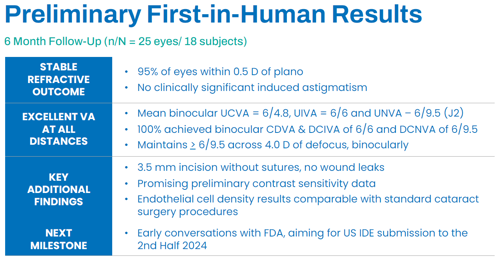IOL
OmniVu Accommodating IOL Moving Forward
Novel AIOL showing promising results in early clinical study.

Howard Larkin
Published: Friday, December 1, 2023
A modular accommodating IOL has shown promising results in early clinical studies, with good visual results over a six-month follow-up period, according to Dee G Stephenson MD.
The OmniVu (Atia Vision) is a modular AIOL intended to simulate the natural accommodative action of the eye. It consists of a fluid-filled base optic that changes shape and refractive power in response to the contraction of the ciliary muscles and a fixed, exchangeable anterior optic targeting the patient’s refraction. The goals are to achieve refractive predictability and stability, restore full functional vision range, and preserve natural vision quality while reducing visual disturbances, Dr Stephenson added.
In a study involving 25 eyes of 18 patients, refractions were stable six months after surgery, with 95% of implanted eyes within 0.50 D of plano, Dr Stephenson reported. “That’s a really stable refraction.”
Visual acuity was also excellent at all distances, yielding vision of 20/32 or better over about 4.00 D of defocus binocularly and 2.75 D monocularly. Mean uncorrected distance visual acuity was 20/16, with distance-corrected intermediate vision of 20/20 and near vision of 20/32, or J2. Contrast sensitivity results are promising, and endothelial cell densities are comparable to existing lenses, he reported.
The lens is implanted in normal cataract surgery, with the base injected into the capsular bag through a manual capsulorhexis of 5.5 mm. Even though the base optic requires enlargement of the incision to 3.5 mm, the study did not detect any clinically significant surgically induced astigmatism, Dr Stephenson said.
Composed of biocompatible silicone, the base optic completely fills the capsular bag and is designed to keep the platform stable. It has a groove into which the edge of the capsulotomy snaps and blue tabs along the periphery to help position it in surgery. No sutures are required to keep the lens stable afterwards or to close the wound.
The bag-filling design also reduces the risk of posterior capsule opacification (PCO). Only 1 of 25 eyes required a posterior capsulotomy for PCO during the study period. Dr Stephenson said the base optic stayed in position and continued to function after the capsulotomy.
The anterior optic is hydrophobic acrylic and can be replaced if the patient is unhappy with their vision. “Exchangeability is just an awesome part of this lens,” Dr Stephenson said.
Following these first-in-human trial results, Atia Vision aims to submit an application in the second half of 2024 to begin clinical trials for registration with the US Food and Drug Administration.
A toric anterior option is also in the works to correct astigmatism.
Dr Stephenson presented at the second ESCRS iNovation Day before the 2023 ESCRS Congress in Vienna.
Dee G Stephenson MD is the director of Stephenson Eye Associates in Venice, Florida, US. eyedrdee@aol.com
